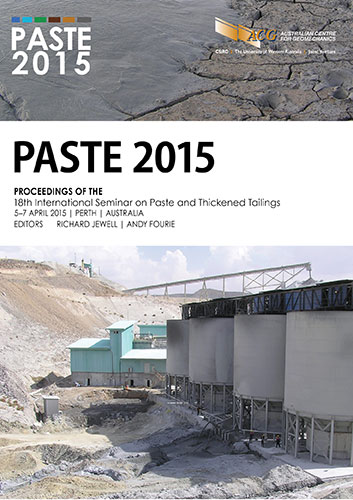Tailings co-disposal case study – art or science?

|
Authors: Beveridge, A; Mutz, P; Reid, D |
DOI https://doi.org/10.36487/ACG_rep/1504_39_Beveridge
Cite As:
Beveridge, A, Mutz, P & Reid, D 2015, 'Tailings co-disposal case study – art or science?', in R Jewell & AB Fourie (eds), Paste 2015: Proceedings of the 18th International Seminar on Paste and Thickened Tailings, Australian Centre for Geomechanics, Perth, pp. 505-520, https://doi.org/10.36487/ACG_rep/1504_39_Beveridge
Abstract:
Murray Zircon Pty Ltd operates the Mindarie Mineral Sands Project in South Australia comprising a mine and concentrator plant. The program for environmental protection and rehabilitation (PEPR) approved by the South Australia Department of Manufacturing, Innovation, Trade, Resources and Energy (DMITRE) requires diligent management of the tailings deposition and overall mine rehabilitation processes. The mining licence was granted based on a maximum permitted operational footprint of the open area of the mine. Mining at Mindarie follows the ‘moving-hole’ concept whereby topsoil and overburden is removed, ore is mined, tailings are deposited in the mined-out space and are then capped by overburden. The moving hole must advance at approximately 10 m per day. Consequently, it is imperative that dewatering, consolidation and stabilisation of deposited tailings happens quickly. Tailings are treated using a high molecular weight polymer which rapidly releases clean water for reuse in the concentrator plant. The polymer binds the coarse and fine particles together to create a non-segregating deposit and accelerates the consolidation rate. Polymer dosing regimes for the tailings have historically relied on a visual interpretation of the material entering the tailings cells to determine the optimum dose; however, it is the consolidation rate and associated strength gain that determines when overburden replacement can begin. To provide an improved assessment of the impacts of dosage on consolidation, geotechnical testing was undertaken on material treated with different polymer levels. A recent development for the Mindarie mine is to adjust the natural acidic pH of tailings to a slightly alkaline level using lime. This was done in order to overcome a throughput bottleneck in the slimes thickener and reduce polymer dosing levels in the slimes thickener and tailings applications. The impact of lime addition on polymer dosing, together with the effect of lime on tailings consolidation properties is also investigated.
References:
Azam, S 2011, ‘Large strain behaviour of polymer-amended laterite slurries’, International Journal of Geomechanics, vol. 11, no. 2, pp. 105-112.
Jeeravipoolvarn, S, Scott, JD & Chalaturnyk, RJ 2009, ‘Geotechnical characteristics of laboratory in-line thickened oil sands tailings’, Proceedings of the Thirteenth International Conference on Tailings and Mine Waste.
Jeeravipoolvarn, S, Scott, JD & Chalaturnyk, RJ 2010, ‘Composite tailings made from in-line thickened oil sands tailings’, Proceedings of the 2nd International Oil Sands Conference, pp. 337-347.
Mutz, P 2014, Mindarie Mineral Sands Project: a new beginning, AUSIMM, Carlton, viewed 1 October 2014, www.ausimm.com.au
/content/docs/branch/2014/adelaide_2014_04_presentation_P.Mutz.pdf
PEPR 2011, Mindarie Mineral Sands Project Mindarie C and A2, Marine Innovation Southern Australia, viewed 1 October 2014, www.misa.net.au/__data/assets/pdf_file/0004/170995/PEPR_main_text.pdf
Porter, TM 2012, Mindarie, Porter GeoConsultancy Pty Ltd, Adelaide, viewed 1 October 2014, www.portergeo.com.au/database
Seneviratne, NH, Fahey, M, Newson, TA & Fujiyasu, Y 1996, ‘Numerical modelling of consolidation and evaporation of slurried mine tailings’, International Journal for Numerical and Analytical Methods in Geomechanics, vol. 20, no. 9, pp. 647-671.
Sheeran, DE & Krizek, RJ 1971, ‘Preparation of homogeneous soils samples by slurry consolidation’, Journal of Materials, vol. 6, no. 2, pp. 356-373.
Takada, N & Mikasa, M 1986, ‘Determination of consolidation parameters by selfweight consolidation test in centrifuge’, in RN Yong & FC Townsend (eds), Proceedings of Consolidation of Soils: Testing and Evaluation, American Society for Testing and Materials, Fort Lauderdale, pp. 548-566.
Yao, D & Znidarcic, D 1997, Crust formation and desiccation characteristics for phosphatic clays: user’s manual for computer program CONDES0, Florida Institute of Phosphate Research, Polk Country.
© Copyright 2026, Australian Centre for Geomechanics (ACG), The University of Western Australia. All rights reserved.
View copyright/legal information
Please direct any queries or error reports to repository-acg@uwa.edu.au
View copyright/legal information
Please direct any queries or error reports to repository-acg@uwa.edu.au